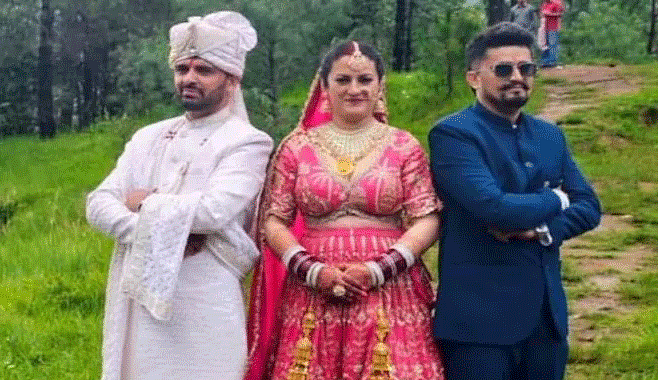One bride, two grooms: Himachal brothers marry same woman in viral ceremony
Rare polyandry marriage was held in Shillai village with full community support

Dubai: In a rare and culturally rich ceremony, two brothers from Himachal Pradesh’s Hatti tribe married the same woman — a revival of the ancient and now-fading tradition of polyandry.
The unique marriage took place in Shillai village, located in the Trans-Giri region of Sirmaur district, with hundreds in attendance.
The three-day celebration, which began on July 12, saw Sunita Chauhan tie the knot with Pradeep and Kapil Negi — a union steeped in age-old customs, according to multiple Indian media reports. Local folk songs, traditional dances, and sacred rituals added vibrancy to the event, now circulating widely on social media through viral videos.
‘We’re proud of this tradition’
The bride and both grooms emphasised that the decision was mutual and without pressure, PTI reported.
“I knew about this tradition and chose it willingly,” said Sunita, who hails from Kunhat village. “I respect the bond we’ve formed.”
Her husband Pradeep, a government employee, said, “We’re proud to follow our tradition openly.”
Kapil, who works abroad, added, “Though I live away, this marriage ensures stability, support, and love for our wife — as a united family.”
Tradition recognised under law
Known locally as “Jodidara”, this form of polyandry is still recognised under Himachal Pradesh’s revenue laws. Though rare today, the practice remains socially accepted in certain areas. In Badhana village alone, five such marriages have been recorded in the last six years.
The Hatti community, declared a Scheduled Tribe in 2022, has around 300,000 people living across approximately 450 villages in the Trans-Giri belt. While polyandry is no longer widespread, it continues quietly in some villages, especially in remote areas. Similar traditions were historically common in Jaunsar Babar (Uttarakhand) and Kinnaur (Himachal Pradesh).
Why polyandry exists — and why it’s fading
Village elders say such marriages now take place discreetly, though they remain socially accepted. Experts trace the origin of this practice to land preservation: marrying brothers to the same woman ensured ancestral property wasn't divided. However, they also note that tribal women’s share in property remains a significant and unresolved concern, according to mint.
According to Kundan Singh Shastri, general secretary of the Kendriya Hatti Samiti, the tradition was formed to meet tribal life’s practical needs. “It helped prevent land fragmentation, promoted unity among brothers — even half-brothers — and ensured security through larger families. In hilly terrain, managing scattered agricultural land requires long-term, joint care,” he said.
“These needs kept polyandry alive for thousands of years, though such traditions are now slowly dying,” Shastri added.
The ‘Jajda’ ceremony: Rituals of a tribal marriage
The wedding followed the traditional “Jajda” ritual. In this, the bride arrives in a colourful procession to the groom’s home, where a sacred rite called “Seenj” is performed. A local priest chants mantras in the native language, sprinkles holy water on the couple, and offers jaggery — symbolising sweetness — while invoking blessings from the family’s Kul Devta (ancestral deity).
As the chants echoed through the hills of Shillai, this rare celebration served as a reminder: some traditions—though old and controversial—still find space in the hearts of those who live by them.
Sign up for the Daily Briefing
Get the latest news and updates straight to your inbox
Network Links
GN StoreDownload our app
© Al Nisr Publishing LLC 2025. All rights reserved.
